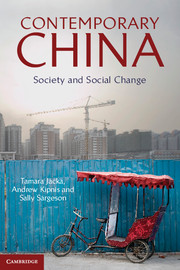Book contents
- Frontmatter
- Contents
- List of Images
- List of Maps
- List of Figures
- List of Tables
- Acknowledgments
- List of Abbreviations
- Map 0.1: China's provinces and provincial capitals
- Introduction
- Part 1 Social Institutions
- Part 2 Cultures, Socialization and the Formation of Identities
- Part 3 Inequalities, Injustices and Social Responses
- 10 Social Class and Stratification
- 11 Regional, Rural–Urban and Within-community Inequalities
- 12 The “Woman Question” and Gender Inequalities
- 13 Collective Action and Social Change
- Glossary of Chinese Terms
- References
- Index
13 - Collective Action and Social Change
Published online by Cambridge University Press: 05 June 2014
- Frontmatter
- Contents
- List of Images
- List of Maps
- List of Figures
- List of Tables
- Acknowledgments
- List of Abbreviations
- Map 0.1: China's provinces and provincial capitals
- Introduction
- Part 1 Social Institutions
- Part 2 Cultures, Socialization and the Formation of Identities
- Part 3 Inequalities, Injustices and Social Responses
- 10 Social Class and Stratification
- 11 Regional, Rural–Urban and Within-community Inequalities
- 12 The “Woman Question” and Gender Inequalities
- 13 Collective Action and Social Change
- Glossary of Chinese Terms
- References
- Index
Summary
In previous chapters, we have discussed several kinds of social change that have taken place in China during the 20th and 21st centuries, including changes in the organization of society, cultures, values and identities and patterns of inequality. We have attributed these changes mostly to changing Chinese state policies and to the processes of modernization. But what about the role of ordinary Chinese citizens in creating social change?
As we noted in the introduction, scholars characterize China today as governed by an authoritarian, single-party state. However, Chinese government is highly decentralized. Far from being united under one homogeneous authority, uniformly enforcing a single set of policies on a mass populace, the policy behavior of state actors and their relationships with non-state actors varies according to their location in different parts of the country, at different levels of government, and in different bureaucracies, coalitions and alliances. In addition, as suggested in previous chapters, high levels of differentiation and inequality also have characterized Chinese society over the past few decades, and there is a great deal of variation between different citizens' outlooks and interests. Also, both leaders and ordinary citizens are increasingly exposed to an array of new and changing non-state as well as state behaviors, norms, expectations and desires. Together, these trends have created both opportunities and pressures for people to initiate, organize and act for social change.
- Type
- Chapter
- Information
- Contemporary ChinaSociety and Social Change, pp. 257 - 274Publisher: Cambridge University PressPrint publication year: 2013



